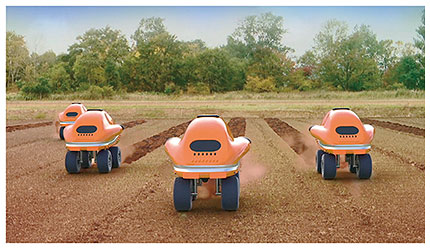 |
|||||||||||||||||||
|
|
|||||||||||||||||||
|
Feature Articles: Initiatives for Smart Agri—Making Japanese Agriculture a Growing Industry Vol. 19, No. 8, pp. 11–16, Aug. 2021. https://doi.org/10.53829/ntr202108fa1 NTT’s Vision for the Future of Agriculture—Initiatives for the Entire Food Value Chain Using IOWN-related TechnologiesAbstractSince 2014, NTT has positioned agriculture as one of its priorities. By using the latest information and communication technology and collaborating with industry-leading partners, NTT has carried out group-wide initiatives to promote Smart Agri to solve problems in the entire food value chain, i.e., from production to distribution, sales, and consumption, in primary industries, such as agriculture, forestry, and fisheries. This article overviews the NTT Group’s initiatives and describes the latest examples of initiatives that will lead to the digital agricultural revolution. Keywords: IOWN, Remote World, food value chain 1. Overview of NTT Group’s initiativesPrimary industries, such as agriculture, forestry, and fisheries, are indispensable for the survival of humankind. However, they face a variety of challenges, including resolving labor shortage, aging population, unstable income due to unseasonable weather, as well as ensuring food security to deliver safe and secure food and nutrition to the public in the face of the recent coronavirus pandemic. As a means to overcome these challenges, technologies such as AgriTech*1 and FoodTech*2 are attracting attention. Since 2014, the Research and Development Planning Department of NTT has been leading the NTT Group’s initiatives for primary industries. In collaboration with NTT laboratories, which develop advanced technologies, and about 30 NTT Group companies with outstanding services, we are promoting a wide range of initiatives with an eye on the entire food value chain, i.e., from production to distribution, sales, and consumption [1]. These initiatives include strategy formulation, research and development (R&D), development of services for commercialization, and dissemination of information on the results of such efforts. By combining NTT’s Innovative Optical and Wireless Network (IOWN)*3 with group companies’ nationwide telecommunication infrastructures, assets, and network services, we will enable innovations in food and agriculture and create new value (Fig. 1).
Specifically, we aim to build an ecosystem that makes it possible to optimize the entire food value chain. This will be enabled by combining multiple efforts such as (i) automating agriculture by remote-control robotics such as agricultural machinery and drones; (ii) digital transformation (DX) in the distribution of agricultural products by simulating real-world information on production and distribution sites in a virtual world and feeding back the results of supply-and-demand forecasts to the real world; and (iii) digital breeding by using bio-technology, microorganisms, genetic technology, etc. to improve the potential of crops, thus dramatically improving productivity and quality. The NTT Group’s current capabilities include greenhouse farming (solar and artificial), outdoor cultivation (including organic farming), livestock, fisheries, weather, map, and topographical information as well as services and technologies that contribute to distribution, sales, and consumption, while meeting the United Nations’ Sustainable Development Goals (SDGs) (Fig. 2). From among those capabilities, initiatives of NTT Group companies in the areas of plant factories using artificial light [2], food-waste recycling solution toward achieving the SDGs [3], fisheries [4], and organic farming using information and communication technology (ICT) [5] are introduced in the Feature Articles in this issue.
2. Example initiative 1Regarding agricultural automation, NTT signed an industry-government-academia comprehensive cooperation agreement in 2019 with fellow signatories Hokkaido University, Iwamizawa City in Hokkaido, NTT EAST, and NTT DOCOMO. Since 2020, Kubota Corporation, a leading manufacturer of agricultural machinery, and other companies have signed up to this initiative, which has been further deepened by using the projects of the Ministry of Agriculture, Forestry and Fisheries and the Ministry of Internal Affairs and Communications. In 2019, we moved an unmanned agricultural machinery in the field (a farm) under remote monitoring using the fifth-generation mobile communication system (5G) and in 2020 carried out inter-field movements in which an agricultural robot moves between fields under remote monitoring, which had been considered extremely difficult [6]. This preliminary demonstration of the Remote World was conducted in Iwamizawa. Regarding the communication network used for that remote monitoring, the coverage area is small due to the frequency characteristics of 5G. Consequently, if an agricultural robot moves out of the area covered by the network system, it will not be possible to check the video while operating the robot from the remote-monitoring center or continue automatic operation. To solve the above-described problem, we verified the effectiveness of several technologies, including a cooperative infrastructure platform, which is an IOWN-related technology, for automatically selecting the most-suitable system from various network systems, such as 5G and broadband wireless access (BWA), in accordance with the operating conditions of the agricultural robot (Fig. 3).
We have also conducted non-technical studies in consideration of business operation, such as formulating safety guidelines in collaboration with national projects and sharing mechanisms for smart agricultural machinery. We plan to implement, at an early stage, the automation of agriculture centered on agricultural robots and launch the business of undertaking agricultural work. We plan to enable innovations that will lead to a digital agricultural revolution in the Remote World we envision. For example, by using IOWN and related technologies that enable higher capacity of networks (more than 100 times current networks), agricultural cooperatives and contractors of agricultural work will be able to monitor and control a large number of robots—agricultural machines, drones, mowers, and harvesters—on wide-area farms from monitoring centers in remote locations and coordinate those robots. We will also model and systematize these technologies and expand them globally to contribute to solving the food shortage facing humankind (Fig. 4).
3. Example initiative 2We are also working to reduce distribution costs, food loss, and ensure food security by optimizing the distribution of agricultural products. Currently, about 80% of fruits and vegetables are traded through more than 1000 wholesale markets throughout Japan, and most are shipped to markets in big cities such as Tokyo and Osaka. If too many products are gathered, the price will drop due to market principles, and transferring the surplus to other markets will incur extra costs. There is also a serious shortage of drivers of trucks for carrying agricultural products. The recent increase in individual deliveries through online shopping and the spread of coronavirus infections are accelerating this problem. To solve these problems, we are planning to build a system that uses Digital Twin Computing, an IOWN-related technology, to predict future supply and demand by using the vast amount of data collected from the wholesale markets, and on the basis of the predicted information, purchases and sales will be completed in a virtual space before the agricultural products are brought to these markets. This system will enable the supply side to supply crops at the right time, place, and quantity, and the demand side to secure crops at the right time, place, and quantity. The system will also help solve social problems through initiatives that take into account the entire food value chain, such as solving driver shortages, reducing food loss and transportation costs, and ensuring food security as well as achieve the SDGs. Marketers, agricultural organizations, and local governments are also becoming more interested in this system, and collaborations and partnerships are expanding. This system is expected to lead to a digital agricultural revolution that will bring about a DX in distribution of agricultural products. 4. Concluding remarksWe believe it is now necessary in Japan to bring together the wisdom and technology of various fields in the primary industries, which are indispensable for the survival of humankind. We need to build a mechanism that accelerates the transformation of existing industries, creates new services, and fundamentally changes the industrial structure of the entire food value chain by taking both perspectives of agriculture with producers in mind and food with consumers in mind. By leveraging the unlimited potential of the ICT of the NTT Group and R&D capabilities of NTT laboratories, we will work with various partners to shape the future of food and agriculture. The NTT Group will continue to be a value partner of choice for all concerned and contribute to the development of primary industries. References
|
|||||||||||||||||||







